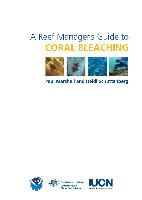Please use this identifier to cite or link to this item:
https://hdl.handle.net/11017/399

Full metadata record
| DC Field | Value | Language |
|---|---|---|
| dc.contributor.author | Marshall, P.A. | * |
| dc.contributor.author | Schuttenberg, H. | * |
| dc.date.accessioned | 2012-05-25T02:48:09Z | en |
| dc.date.available | 2012-05-25T02:48:09Z | en |
| dc.date.copyright | 2006 | en |
| dc.date.issued | 2006 | en-US |
| dc.identifier.isbn | 9781876945404 | en |
| dc.identifier.uri | https://hdl.handle.net/11017/399 | en |
| dc.description.abstract | Scientists agree that tropical seas will continue to warm over coming decades, increasing both the probability and severity of mass bleaching events8-11. These scenarios pose particular challenges to coral reef managers, not the least because the main cause of mass coral bleaching–anomalously warm sea temperatures–is largely beyond their control.Yet, managers can play a critical role in helping reefs survive the threat of coral bleaching. Managers are in a unique position to increase our understanding of the phenomenon of coral bleaching, to take meaningful action during a bleaching event, and to develop strategies to support the natural resilience of reefs in the face of long-term changes in climate. Because of increasingly strong collaborations between reef managers and scientists, strategies are being developed to directly address the threat of coral bleaching. Management needs and preliminary strategies were first documented in 2000, when the IUCN published Management of Bleached and Severely Damaged Coral Reefs12. In 2002, the US Coral Reef Task Force called for a collaborative effort to identify actions local managers could take to address the impacts of climate change and mass bleaching on coral reefs. In response, three US government agencies (the National Oceanic and Atmospheric Administration, Environmental Protection Agency, and the Department of the Interior) convened an international workshop entitled 'Coral Reefs, Climate Change and Coral Bleaching' in June 2003. This workshop significantly advanced thinking about the strategies that could support managers in their efforts to respond to coral bleaching. | en |
| dc.language.iso | en | en |
| dc.publisher | Great Barrier Reef Marine Park Authority | en |
| dc.relation.ispartofseries | Technical Report Series | en |
| dc.relation.ispartofseries | Not a policy under s7(4) of the GBRMP Act 1975 | - |
| dc.relation.ispartofseries | Technical Report Series | - |
| dc.subject | Great Barrier Reef (Qld.)-Climate | null |
| dc.title | A reef manager's guide to coral bleaching | en |
| dc.type | Report | en |
| dc.subject.asfa | Climatic changes | en |
| dc.subject.asfa | Coral reefs | en |
| dc.subject.asfa | Bleaching | en |
| dc.format.pages | 176 | en |
| dc.contributor.corpauthor | Great Barrier Reef Marine Park Authority | en |
| dc.subject.apais | Environmental management | en |
| dc.subject.apais | Environmental impact | en |
| dc.publisher.place | Townsville, Qld. | en |
| dc.subject.collection | Managing Multiple Use | en |
| dc.relation.connectiontogbrmpa | GBRMPA published this item | en |
| dc.subject.category | Leading environmental practice | en |
| dc.subject.category | Climate change | en |
| dc.subject.category | Extreme events | en |
| dc.subject.category | Reef managers | en |
| dc.subject.theme | People and actions | en |
| dc.subject.theme | Managing Multiple Use | en |
| dc.subject.theme | Effects on the Reef | en |
| dc.subject.location | Reef-wide | en |
| dc.keywords | Coral reef ecology | en |
| dc.keywords | Coral reef conservation | en |
| dc.keywords | Coral reefs and islands | en |
| dc.keywords | Climate change | en |
| Appears in Collections: | Management | |
Files in This Item:
| File | Description | Size | Format | |
|---|---|---|---|---|
| A-reef-managers-guide-to-coral-bleaching.pdf | 4.83 MB | Adobe PDF |  View/Open |
Items in ELibrary are protected by copyright, with all rights reserved, unless otherwise indicated.
